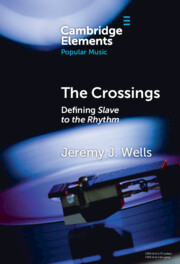139 results
One - Introduction to the Analysis of Greek Iron Age Pottery in the Mediterranean World
-
-
- Book:
- Greek Iron Age Pottery in the Mediterranean World
- Published online:
- 30 May 2024
- Print publication:
- 06 June 2024, pp 1-13
-
- Chapter
- Export citation
3 - WTO Disputes on Anti-dumping Procedures
-
- Book:
- Improving Procedural Justice in Anti-Dumping Investigations
- Published online:
- 09 May 2024
- Print publication:
- 16 May 2024, pp 63-107
-
- Chapter
- Export citation

The Crossings
- Defining Slave to the Rhythm
-
- Published online:
- 26 October 2023
- Print publication:
- 23 November 2023
-
- Element
- Export citation
19 - Djent and the Aesthetics of Post-Digital Metal
- from Part V - Modern Metal Genres
-
-
- Book:
- The Cambridge Companion to Metal Music
- Published online:
- 31 August 2023
- Print publication:
- 14 September 2023, pp 265-280
-
- Chapter
- Export citation
3 - Conducting and Evaluating Research
- from Part I - Foundational Ideas of Relationship Science
-
- Book:
- The Science of Romantic Relationships
- Published online:
- 17 August 2023
- Print publication:
- 31 August 2023, pp 81-120
-
- Chapter
- Export citation
1 - Introduction
-
- Book:
- Conflict Refugees
- Published online:
- 20 July 2023
- Print publication:
- 10 August 2023, pp 1-17
-
- Chapter
- Export citation
Chapter 2 - Homo Ordinalus and Sampling Models
- from Part I - Historical Review of Sampling Perspectives and Major Paradigms
-
-
- Book:
- Sampling in Judgment and Decision Making
- Published online:
- 01 June 2023
- Print publication:
- 15 June 2023, pp 35-65
-
- Chapter
- Export citation
Chapter 13 - Sequential Decisions from Sampling:
- from Part IV - Truncation and Stopping Rules
-
-
- Book:
- Sampling in Judgment and Decision Making
- Published online:
- 01 June 2023
- Print publication:
- 15 June 2023, pp 289-310
-
- Chapter
- Export citation
Chapter 19 - Opinion Homogenization and Polarization
- from Part V - Sampling as a Tool in Social Environments
-
-
- Book:
- Sampling in Judgment and Decision Making
- Published online:
- 01 June 2023
- Print publication:
- 15 June 2023, pp 436-464
-
- Chapter
- Export citation
Chapter 6 - Sampling as Preparedness in Evaluative Learning
- from Part II - Sampling Mechanisms
-
-
- Book:
- Sampling in Judgment and Decision Making
- Published online:
- 01 June 2023
- Print publication:
- 15 June 2023, pp 131-152
-
- Chapter
- Export citation
Chapter 4 - The Hot Stove Effect
- from Part I - Historical Review of Sampling Perspectives and Major Paradigms
-
-
- Book:
- Sampling in Judgment and Decision Making
- Published online:
- 01 June 2023
- Print publication:
- 15 June 2023, pp 90-112
-
- Chapter
- Export citation
Chapter 12 - The Collective Hot Stove Effect
- from Part III - Consequences of Selective Sampling
-
-
- Book:
- Sampling in Judgment and Decision Making
- Published online:
- 01 June 2023
- Print publication:
- 15 June 2023, pp 266-286
-
- Chapter
- Export citation
Chapter 3 - In Decisions from Experience What You See Is Up to Your Sampling of the World
- from Part I - Historical Review of Sampling Perspectives and Major Paradigms
-
-
- Book:
- Sampling in Judgment and Decision Making
- Published online:
- 01 June 2023
- Print publication:
- 15 June 2023, pp 66-89
-
- Chapter
- Export citation
Chapter 7 - The Dog that Didn’t Bark
- from Part II - Sampling Mechanisms
-
-
- Book:
- Sampling in Judgment and Decision Making
- Published online:
- 01 June 2023
- Print publication:
- 15 June 2023, pp 153-176
-
- Chapter
- Export citation
Chapter 22 - Sampling Data, Beliefs, and Actions
- from Part VI - Computational Approaches
-
-
- Book:
- Sampling in Judgment and Decision Making
- Published online:
- 01 June 2023
- Print publication:
- 15 June 2023, pp 513-548
-
- Chapter
- Export citation
Chapter 10 - Evaluative Consequences of Sampling Distinct Information
- from Part III - Consequences of Selective Sampling
-
-
- Book:
- Sampling in Judgment and Decision Making
- Published online:
- 01 June 2023
- Print publication:
- 15 June 2023, pp 222-244
-
- Chapter
- Export citation
9 - Participant Recruitment
- from Part II - The Building Blocks of a Study
-
-
- Book:
- The Cambridge Handbook of Research Methods and Statistics for the Social and Behavioral Sciences
- Published online:
- 25 May 2023
- Print publication:
- 08 June 2023, pp 179-201
-
- Chapter
- Export citation
7 - Analyzing Data
- from Part I - From Idea to Reality: The Basics of Research
-
-
- Book:
- The Cambridge Handbook of Research Methods and Statistics for the Social and Behavioral Sciences
- Published online:
- 25 May 2023
- Print publication:
- 08 June 2023, pp 125-155
-
- Chapter
- Export citation
Chapter 5 - The Natural Experiment, a.k.a. the Single Embedded Design
-
- Book:
- Combining Case Study Designs for Theory Building
- Published online:
- 02 February 2023
- Print publication:
- 09 February 2023, pp 78-103
-
- Chapter
- Export citation



